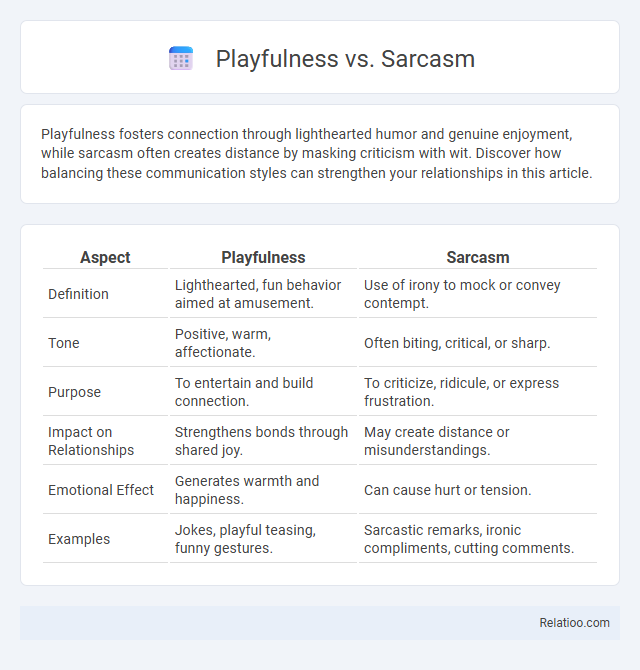Playfulness fosters connection through lighthearted humor and genuine enjoyment, while sarcasm often creates distance by masking criticism with wit. Discover how balancing these communication styles can strengthen your relationships in this article.
Table of Comparison
| Aspect | Playfulness | Sarcasm |
|---|---|---|
| Definition | Lighthearted, fun behavior aimed at amusement. | Use of irony to mock or convey contempt. |
| Tone | Positive, warm, affectionate. | Often biting, critical, or sharp. |
| Purpose | To entertain and build connection. | To criticize, ridicule, or express frustration. |
| Impact on Relationships | Strengthens bonds through shared joy. | May create distance or misunderstandings. |
| Emotional Effect | Generates warmth and happiness. | Can cause hurt or tension. |
| Examples | Jokes, playful teasing, funny gestures. | Sarcastic remarks, ironic compliments, cutting comments. |
Understanding Playfulness: Definition and Key Traits
Playfulness involves a lighthearted, spontaneous attitude characterized by creativity, humor, and a willingness to engage in fun without harm. Unlike sarcasm, which often carries a biting or ironic tone intended to mock or criticize, playfulness fosters positive social interactions and emotional connection. Understanding playfulness helps you promote joyful communication, enhancing relationships through genuine amusement and openness.
Defining Sarcasm: Origins and Characteristics
Sarcasm originates from the Greek word "sarcasmos," meaning "to tear flesh," and is characterized by sharp, often ironic remarks intended to mock or convey contempt. Unlike pure playfulness, which is lighthearted and aims to amuse, sarcasm uses biting humor that can be both witty and hurtful. Recognizing sarcasm involves understanding tone, context, and the speaker's intent to distinguish it from genuine playful banter.
Emotional Impact: Playfulness vs Sarcasm
Playfulness fosters positive emotional connections by encouraging lighthearted interactions and reducing stress, creating a sense of warmth and trust. Sarcasm often generates mixed emotional responses, sometimes leading to confusion or hurt feelings due to its ambiguous tone and potential for misunderstanding. Your use of playfulness can enhance social bonding and emotional well-being, while sarcasm may risk emotional harm if not carefully balanced.
Communication Styles: How Playfulness Differs from Sarcasm
Playfulness in communication fosters positive social interactions through humor, light-heartedness, and genuine engagement, often strengthening relationships and conveying warmth. Sarcasm, by contrast, involves ironic or cutting remarks that may be misunderstood, potentially leading to confusion or hurt feelings due to its veiled criticism. Understanding these distinct communication styles enhances emotional intelligence and improves interpersonal effectiveness in both personal and professional contexts.
Social Perceptions: Positive vs Negative Interpretations
Playfulness is often perceived positively as a sign of creativity, warmth, and approachability, fostering social bonding and easing communication. Sarcasm, however, tends to evoke mixed reactions, where some view it as witty and clever while others interpret it as hostile or insulting, potentially damaging relationships. The balance between playful teasing and sarcasm hinges on context, tone, and the existing rapport, significantly influencing whether social interactions are seen as friendly or antagonistic.
Psychological Effects: Benefits and Pitfalls
Playfulness promotes positive psychological effects such as reduced stress, enhanced creativity, and improved social bonding by encouraging lighthearted interaction and openness. Sarcasm, while potentially fostering wit and critical thinking, often carries risks of misunderstanding and emotional harm, leading to increased tension and decreased trust in relationships. You must balance playful humor carefully to enjoy its benefits without the pitfalls of sarcasm, ensuring communication remains supportive and enjoyable.
Playfulness and Relationship Building
Playfulness fosters positive interactions by encouraging trust, creativity, and emotional connection, making it a vital tool in relationship building. Unlike sarcasm, which can create misunderstandings or hurt feelings, playfulness promotes openness and bonding by easing communication and reducing tension. Your ability to engage playfully enhances rapport and strengthens interpersonal dynamics effectively.
Sarcasm and Miscommunication Risks
Sarcasm often involves using irony to convey contempt or humor, which can easily lead to miscommunication when your tone or intent is misunderstood. Unlike straightforward playfulness, sarcasm relies heavily on context and shared understanding, increasing the risk that your message will be interpreted as offensive or insincere. Clear communication and awareness of your audience's sensitivity are essential to minimize these misunderstandings.
Cultural Influences on Playfulness and Sarcasm
Cultural influences significantly shape the expression and interpretation of playfulness and sarcasm, with some cultures valuing playful communication as a form of social bonding while others may view sarcasm as a preferred mode of humor or critique. In collectivist societies such as Japan and China, subtle playfulness aligns with social harmony and face-saving, whereas sarcasm is often less tolerated or deemed rude. Western cultures like the United States and the United Kingdom frequently embrace sarcasm as a sophisticated or witty form of social interaction, reflecting differing cultural norms around humor and communication styles.
Choosing the Right Tone: Navigating Playfulness and Sarcasm
Choosing the right tone between playfulness and sarcasm hinges on understanding context and audience sensitivity to avoid miscommunication. Playfulness fosters positive engagement and rapport through lightheartedness, while sarcasm, often laced with irony, risks offending if recipients misinterpret intent. Mastering this balance enhances social interactions by ensuring humor aligns with emotional cues and relationship dynamics.

Infographic: Playfulness vs Sarcasm
 relatioo.com
relatioo.com